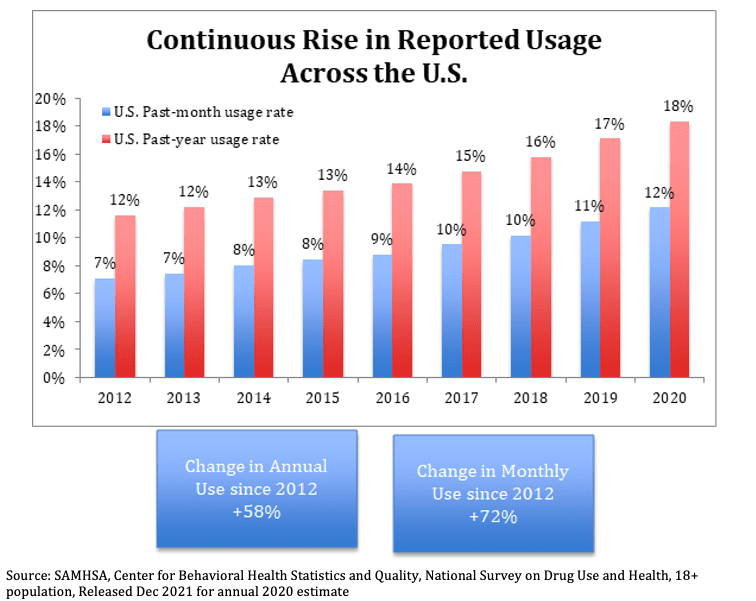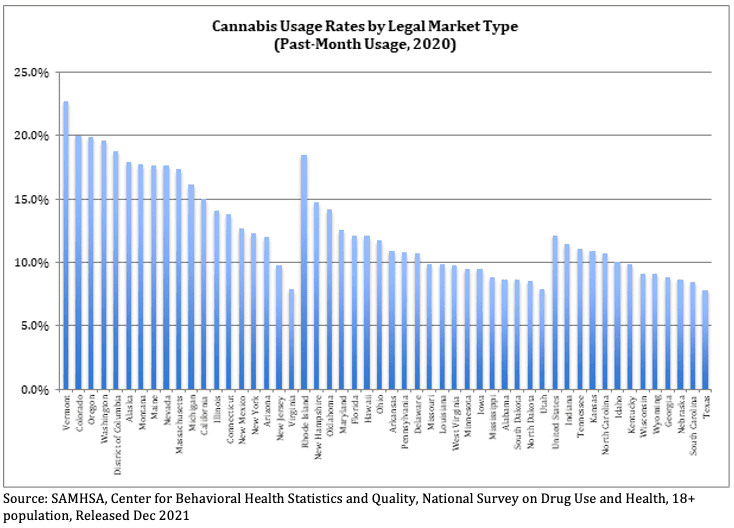Almost 1/5 of Americans Report Consuming Cannabis Each Year

Which States Are Looking to Legalize Cannabis This Year?
March 8, 2022
New State Markets Could Boost U.S. Legal Cannabis Sales to $72B by 2030
March 21, 2022By John Kagia, Chief Knowledge Officer, New Frontier Data; and Kacey Morrissey, Senior Director of Industry Analytics, New Frontier Data
In marking new records for U.S. consumption, approximately 12% of American adults aged 18+ report using cannabis at least monthly, with 18% report having used it within the past year, according to the National Institutes of Health (NIH)’s National Survey on Drug Use and Health (NSDUH).
According to the NIH, the number of regular cannabis users in the country has grown by 15 million since 2010 (surpassing 31 million in 2020). The increase is attributed to converging factors, including broader acceptance and socialization of cannabis use as more states legalize it for medical and/or adult use, and more adults feel comfortable in reporting their use for a governmental survey.
With more than 1 in 10 Americans consuming cannabis regularly (and nearly 1 in 5 doing so at least once a year), acceptance of the drug in the U.S. has broad implications for the presence and visibility of cannabis throughout U.S. society. Generally, those states having the highest self-reported rates are also those with the most liberalized related policies — from the range of commercially available products, to lists of qualifying medical conditions, to expungement of cannabis-related crimes, and promotion of social-equity programs.
States with legalized adult-use markets tend to see higher usage rates than those with medical-only markets. States prohibiting cannabis typically report lower rates of use. Correspondingly, between 2010-2020, states with respectively liberalized policies reported the highest increases: Notably, Vermont — which voted in a legal cannabis marketplace in 2020 — has seen the nation’s highest reported consumption rate (23%), with nearly one-quarter of residents consuming each month.
Between 2019 and 2020, significantly pronounced changes were reported among some historically conservative states: Oklahoma, Iowa, Louisiana, and the Dakotas respectively registered the highest reported one-year increases after long claiming the lowest such rates in the country.
Oklahoma is home to the country’s fastest-growing medical cannabis market, while South Dakota was the first state to simultaneously approve both medical and adult-use legalization via ballots in a single election cycle (though the latter was overturned following a challenge by the state’s governor). Louisiana has amended its medical cannabis program to approve flower sales for the first time, and cannabis reform has become a top issue in the state’s campaign for a U.S. Senate seat this fall.
While the rising rates of cannabis highlight significant progress which the U.S. legal cannabis industry has seen in bringing cannabis consumers out of the shadows and onto Main Street, it remains worthwhile to note how much lower the public’s use of cannabis remains in comparison to alcohol, the country’s most widely used drug. While 12% of American adults report using cannabis at least once a month, more than half (55%) of Americans use alcohol with such frequency.
As New Frontier Data has previously analyzed, the interplay between alcohol and cannabis will be a critical trend to monitor throughout the coming decade. As detailed in New Frontier Data’s 2021 cannabis consumer survey, 44% of cannabis consumers preferred cannabis to alcohol, while 47% substituted cannabis for some of their drinking.
As numbers of cannabis consumers increase, and access to regulated, high-quality products becomes more common (including in social-use spaces designed to rival bars and coffee shops), greater substitution is to be expected from alcohol to cannabis. The trend will predictably be most pronounced among young adults, coming of age in environments where cannabis is as socially accepted as alcohol, though broadly deemed as a safer option. The full impact of that trend may take another decade or beyond to be manifested in the mainstream, but presents itself among the most significant and enduring impacts of the legalized cannabis industry.



As reported in the NSDUH, Oklahoma most recently saw the highest increase in past-year cannabis usage, due largely to the opening of the state’s easily accessible legal medical market, the expansion and success of which has decreased stigma and increased public comfort levels across the state for admitting usage.


The states with the lowest reported usage rates are the most historically conservative states in the South and Midwest, which have had the most punitive cannabis laws over the past half-century.
As the confluence of each among the described trends reaches critical mass, the usage rates seen across demographic cohorts will expectedly rise further. Accordingly, constituencies in favor of legalization may be expected to lend ever-increasing mass to voting blocs. Such trends will hasten the seismic social shift in support as more legal state markets open, and their proponents increase public and political pressure against federal prohibition.




